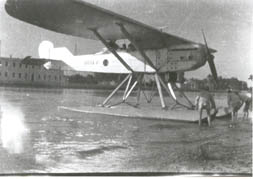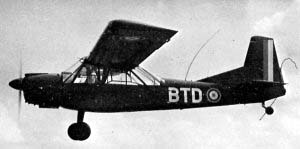
The Albatros L 75 Ass was a German trainer biplane of the 1920s. Of conventional configuration, it seated the pilot and instructor in separate, open cockpits. The wings were single-bay, equal-span, and had a slight stagger. Production continued after Albatros was absorbed by Focke-Wulf.

The Arado S I was a biplane trainer built in Germany in 1925. The first of three prototypes was powered by a Bristol Lucifer radial engine, while the other two Arado S.Ia aircraft were fitted with the Siemens-Halske Sh 12. The Siemens-Halske Sh 11 powered the Arado S III, a virtually identical aircraft of which only a single prototype was constructed and sold to Turkey.

The Maurice Farman MF.11 Shorthorn is a French aircraft developed before World War I by the Farman Aviation Works. It was used as a reconnaissance and light bomber during the early part of World War I, later being relegated to training duties.

The Fiat CR.1 was an Italian biplane fighter aircraft of the 1920s. Of wood-and-fabric construction, it was designed by Celestino Rosatelli, from whom it gained the 'CR' designation. Its most distinctive feature was that the lower wings were longer than the upper ones.

The Avia BH-26 was a two-seat armed reconnaissance aircraft built in Czechoslovakia in 1927. It was a single-bay unstaggered biplane with equal-span wings and a fixed tailskid undercarriage. Both upper and lower wings featured long-span ailerons, which were dynamically balanced by a small auxiliary airfoil mounted to the upper surface of the lower ailerons. Its design was typical of this type of aircraft built during World War I and the years following; pilot and observer sat in tandem open cockpits with the observer armed with a machine gun on a ring mount. As with many other Avia designs, the BH-26 originally had no fixed fin, only a rudder, but this was changed in service.

The Bleriot-SPAD S.51 was a French fighter aircraft developed in 1924 in response to a French Air Force requirement for an aircraft to replace their obsolete Nieuport-Delage NiD.29s.

The Breda A.7 was a reconnaissance aircraft developed in Italy for use by the Regia Aeronautica in 1929. It was a braced parasol monoplane of conventional configuration with tailskid undercarriage. The pilot and observer sat in tandem, open cockpits. A single prototype of a long-range example, originally designated A.7 Raid and later A.16 was also constructed, but the air force showed no interest in it.

The SIA 7B was a biplane reconnaissance-bomber built by the Società Italiana Aviazione and served with the Italian Corpo Aeronautico Militare and American Expeditionary Force in 1917.

The Fiat G.12 was an Italian transport aircraft of World War II.

The Dewoitine D.21 was 1920s French open-cockpit, fixed-undercarriage monoplane fighter aircraft.

The Dewoitine D.19 was a fighter aircraft built in France in 1925 in response to a French Air Force solicitation.

The Fiat B.R. 1/4 was a light bomber series, developed in Italy shortly after World War I.

The Focke-Wulf A 20 Habicht was an airliner developed in Germany in the late 1920s. It was a high-wing cantilever monoplane with fixed tailskid undercarriage. The fuselage was deep and seated four passengers in a fully enclosed cabin. The type was not bought by the airlines and only a few examples were built.

The Focke-Wulf S 2 was a trainer aircraft built in Germany in the late 1920s. It was a conventional parasol-wing monoplane with fixed tailskid undercarriage. The pilot and instructor sat side by side in an open cockpit. Only a single example was built.

The Nord 3400 Norbarbe was a French two-seat observation and casualty-evacuation aircraft built by Nord Aviation for the French Army Light Aviation.
The Partenavia P.55 Tornado was a 1950s Italian high-performance competition and touring monoplane built by Partenavia. The Tornado was a small mid-wing cantilever monoplane with a retractable tricycle landing gear. The aircraft was powered by a nose-mounted Lycoming O-320 piston engine.
The Beardmore W.B.II was a British biplane fighter prototype of the 1910s.

The Macchi M.41 was an Italian flying boat fighter prototype of 1927 designed and manufactured by Macchi. Its production model, the M.41bis, first flown in 1929, was in front line service from 1930 to 1938.

The Macchi M.15 was an Italian reconnaissance aircraft, bomber and trainer, designed by Alessandro Tonini and Piero Bergonzi and built by Macchi.

The Breda A.14 was a prototype three-engined biplane, designed by Società Italiana Ernesto Breda as a night bomber in 1928.


















